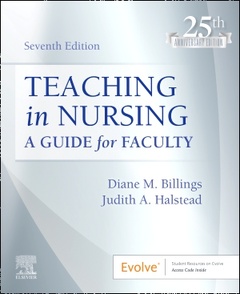Description
Teaching in Nursing (7th Ed.)
A Guide for Faculty
Authors: Billings Diane M., Halstead Judith A.
Language: English
Subject for Teaching in Nursing:
109.28 €
In Print (Delivery period: 14 days).
Add to cart696 p. · 19x23.4 cm · Paperback
Description
/li>Contents
/li>
Now in its 25th-anniversary edition, Billings and Halstead's Teaching in Nursing: A Guide for Faculty, 7th Edition prepares you for the day-to-day challenges of teaching future nurses for practice in today's rapidly evolving healthcare system. This comprehensive resource covers all four components of nursing education: teaching and learning, curriculum, evaluation, and technology-empowered learning. You'll benefit from the expert guidance on such key issues as curriculum and test development, diverse learning styles, the redesign of healthcare systems, advances in technology and information, global health and curricular experiences, the flipped classroom, interprofessional education, and interprofessional collaborative practice. New to the 7th edition is a full-color design for improved learning and reference; increased use of illustrations, tables, and boxes to promote learning through enhanced usability; updated content throughout to reflect the latest trends in nursing education, including up-to-date content on the Next-Generation NCLEX® Exam; expanded use of high-quality case studies throughout the book; chapter-ending key points; new practice questions for nurse educator certification on a companion Evolve website; and much more!
- UNIQUE! Chapter on Global Health and Curricular Experiences focuses on internationalization of the nursing curriculum, with an emphasis on leading international learning experiences; policies, procedures, and guidelines for overseas study; and global and health competencies for health professions programs.
- Coverage of concept-based curricula includes strategies on how to approach and implement concept-based instruction.
- Pedagogical aids include Reflecting on the Evidence boxes, covering such issues as how to do evidence-based teaching; applications of evidence-based teaching; implications for faculty development, administration, and the institution; and how to use the open-ended application questions at the end of each chapter for faculty-guided discussion.
- Strategies to promote clinical judgment and active learning are incorporated throughout the text, highlighting various evaluation techniques, lesson planning insights, and tips for developing examinations.
- Guidance on teaching in diverse settings addresses such topics as the models of clinical teaching, teaching in interdisciplinary settings, how to evaluate students in the clinical setting, and how to adapt teaching for community-based practice.
- Strong emphasis on teaching clinical judgment, new models of clinical education, and responding to needs for creating inclusive multicultural teaching-learning environments.
- NEW! Updated content throughout reflects the latest evidence-based guidelines for best practices in teaching and learning.
- NEW! Expanded use of high-quality case studies (two per chapter on average) serves to model sound judgment for beginning nurse educators.
- UNIQUE!Full-color design and expanded use of illustrations, tables, and boxes improves accessibility and promotes learning through improved visual appeal.
- NEW! Updated content reflects changes in nursing education related to the global COVID-19 pandemic, including the shift to online learning, increased reliance on virtual experiences in lieu of face-to-face clinical experiences, and more.
- NEW! Updated content includes guidance on preparing students for the Next-Generation NCLEX® Examination, which represents the most significant revision in the licensure exam since the rollout of alternate-format questions.
- NEW! Chapter-ending key points serve as a helpful review and nurse education certification study aid.
- NEW and UNIQUE! Practice questions for nurse educator certification on the Evolve companion website expand the book's utility as a nurse educator certification review resource.
UNIT I: Faculty and Students 1. Teaching in Nursing: The Faculty Role 2. Strategies to Support Diverse Learning Needs of Students 3. The Academic Performance of Students: Legal and Ethical Issues 4. Facilitating Learning for Students with Disabilities
UNIT II: Curriculum as a Process 5. Forces and Issues Influencing Curriculum Development 6. An Introduction to Curriculum Development 7. Philosophical Foundations of the Curriculum 8. Curriculum Models for Prelicensure Programs 9. Curriculum Models for Graduate Programs 10. Designing Courses and Learning Experiences 11. Interprofessional Education and Collaborative Practice 12. Service Learning: Developing Values, Cultural Competence, Global Awareness, and Social Responsibility 13. Global Health and Curricular Experiences New
UNIT III: Teaching and Learning 14. Theoretical Foundations of Teaching and Learning 15. Managing Student Incivility and Misconduct in the Learning Environment 16. Strategies to Promote Student Engagement and Active Learning 17. Multicultural Education in Nursing 18. Teaching in the Clinical Setting
UNIT IV: Technology-Empowered Learning 19. Teaching and Learning Using Simulations 20. The Connected Classroom: Using Digital Technology to Promote Learning 21. Teaching and Learning at a Distance 22. Teaching and Learning in Online Learning Communities
UNIT V: Evaluation 23. Introduction to the Evaluation Process 24. Strategies for Evaluating Learning Outcomes 25. Developing and Using Classroom Tests 26. Clinical Performance Evaluation 27. Systematic Program Evaluation 28. The Accreditation Process
Index
These books may interest you

Scope of Practice 20.53 €



